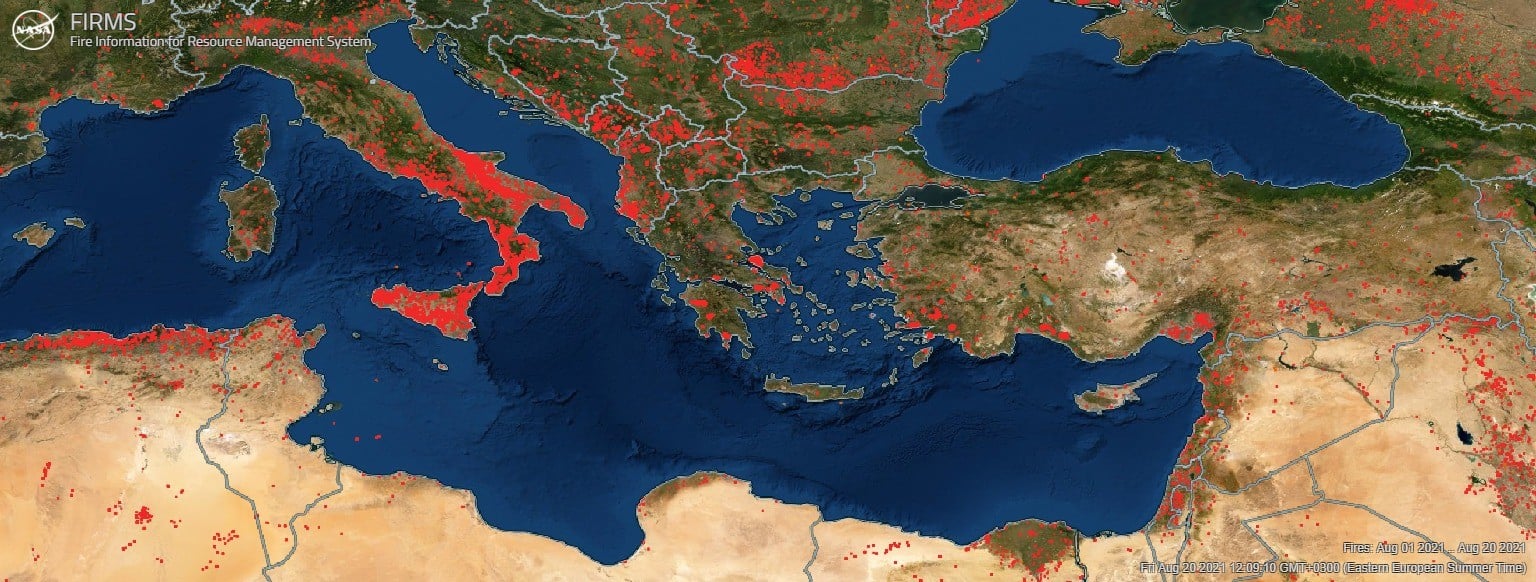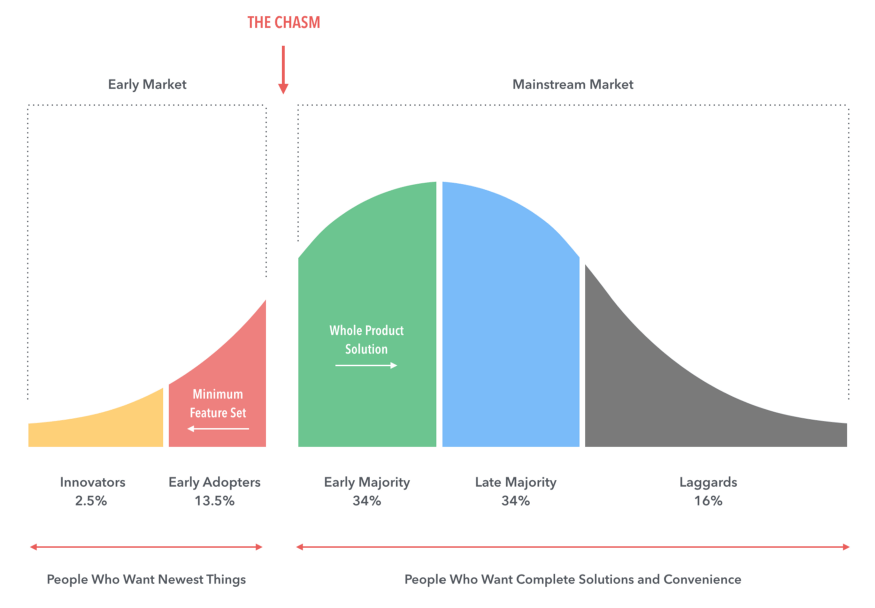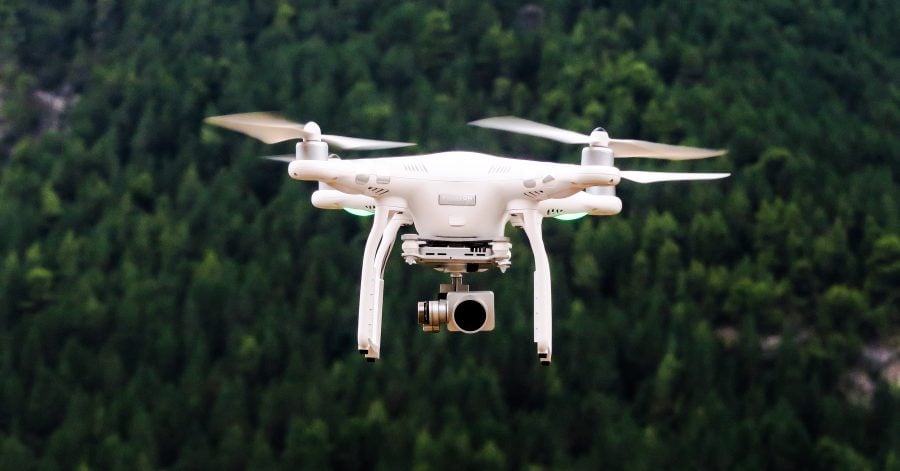Prevention is better than cure. Yet, every year we are still waiting for wildfires to destroy communities, human lives, and forest ecosystems. In 2021, countries in Southeast Europe are facing the most severe fire disasters in decades, same as multiple other regions all over the world. Hundreds of victims, homes turned to ash, arable land – gone. Economic cost is hard to estimate but likely in the billions of euro for most affected nations.
Wildfires, while more extreme in recent times, are not a new problem. But we do have new solutions. The technology that can limit the eruption or spread of uncontrolled* wildfires is already here. Geospatial analytics systems can be used to map high-risk areas and even predict eruption probability so that proactive actions are taken. Drones and a combination of electro-optic and thermal sensors can make sure that the fires that do start are noticed within minutes., And,so that firefighters are warned in a timely manner. Both of these tasks are next to impossible to be done efficiently by humans.
There are numerous tech solutions like those developed by companies and researchers in Greece, Bulgaria, and North Macedonia. However, “adoption is still moderate,” tells us Ruslan Papazyan, Executive Director of Telelink Infra Services, one of the companies that provides sensor-based systems for 24/7 monitoring and fire identification.
Yes, it takes time for every innovation to ‘cross the chasm’ and reach the mass market. In this case, time is not a luxury the world can afford, though. According to the European Space Agency, about 4 million square kilometers of land burn each year. Given the current trends, this number is likely to increase. For instance, data from The European Forest Fire Information System (EFFIS) shows that this August the total burned area is more than twice the average for the same dates in the 2008-2020 period.
In this analysis, The Recursive explores why the adoption of wildfire prevention technologies is still slow and what can everyone do about it. Public sector companies may often be the client but it’s also the responsibility of startups and corporates to communicate more effectively and offer more complete products. Media outlets also need to go beyond the reporting of tragic news and start looking for solution-based stories.

Changing people’s mind is never easy
According to Rogers’ innovation diffusion theory, adopters evaluate new technology across 5 attributes – relative advantage, compatibility with existing values, complexity or ease of use, trialability, and observability of results. Of course, one also needs to be aware of the innovation’s benefits and risks in the first place – thus, communication channels and approaches also have a big influence on the rate of adoption.
When it comes to relative advantages, there’s one measurement that really matters – how early we become aware of a potentially dangerous wildfire. Similar to heart attacks, the best option is to have some warning data before the actual event happens. In recent years, algorithms have reached over 93% accuracy in forecasting fires, which is likely better than any human team can do. Even in case of an active fire, sensors and unmanned aerial vehicles can notify firefighting service in a matter of minutes; not hours or even days. Drones can also fly fairly close to fires and provide further situational awareness, making it a little bit less dangerous for humans, compared to helicopters. This data may also be invaluable in predicting the future direction of the disaster.
The preventive nature of these innovations, however, make the assessment of the relative advantage a bit more difficult. The desired consequence is delayed in the future and hard to observe. Long-term thinking is not a strength many public sector leaders in Southeast Europe have, so in their minds, it’s easier to justify spending on more “obvious” priorities and hope something bad won’t happen.
(This map – best viewed on desktop – doesn’t claim to be a complete picture of all tech projects and providers – if yours is not included, please send us some additional info at [email protected])
No matter the remote sensing approach, it’s true that today the cost of such a system would be relatively high. Nonetheless, this shouldn’t be a big obstacle. After all, the Greek prime minister just approved a €500m budget for wildfire relief. Wouldn’t it have been better to spend them before this summer on preventative tech? Most likely, there will be billions available in EU funding for such projects – either under Horizon Europe or NextGenerationEU. Last but not least, the higher the market demand, the lower the cost would go.
The bigger problem that emerged in our conversations with stakeholders in the fire prevention tech ecosystem, was the topic of compatibility with values.
“The main issue of drones not being massively utilized is that people don’t understand the meaning of being proactive. Most of them can not accept that by being proactive you can fight fires even before they begin,” George Delaportas, co-founder and CEO at drone system integrator Probotek tells The Recursive.
Another mindset challenge seems to be that people working in organizations with high public impact tend to avoid taking risks. Enview, a platform that automates the analysis of 3D geospatial data and helps utility companies address dangerous vegetation before it starts a wildfire, is one example for that.
“Change in any organization is hard, but especially at large utility companies whose service is so mission-critical. Employees are careful in making decisions as any failure could have a large and very public consequence,” tells us Krassimir Piperkov, Chief Operating Officer at Enview, a startup company which last year closed a $12M round led by Sofia-based venture capital firm BrightCap Ventures. We can easily imagine that this statement will be true for both firefighters and municipalities.
Bridging the gap
The mindset and knowledge challenges can be addressed from several perspectives – educational and awareness campaigns are no doubt the first step.
Next? Pilot projects that carry next to no risks and can show results in practice. “We should have multiple PoCs and small scale tests under various scenarios with the assistance and support of large corporations,” states Delaportas.
Pilot projects can be facilitated in several different ways – sandboxes, accelerators, innovation labs, and marketplaces, to name a few.
In Greece, a project with good initial success (although in different verticals) has been Athens Digital Lab, a municipality-driven initiative to help the commercialization of IoT solutions that improve quality of life in the city. In Sofia, the municipality just started a sandbox program for the co-creation of sustainable urban solutions. The first few projects were selected in July, we’re yet to see the results.
Such projects give young companies the opportunity to get familiar with public sector policies, test solutions in the field in a secure regulatory environment, and add some external reference to help them with future sales. Municipalities get to see visible results without spending lots of public money and risking unhappiness from their electorate.
Municipal or forest services accelerators are also worth exploring, as acceleration programs provide this one bit of extra structure and focus that’s quite important in the early-stages. This model has been quite successful in Southeast Europe, although in another industry – currently, there are at least 6 corporate fintech accelerators across Bulgaria, Greece, and Romania. These programs have helped tens of emerging startups find their first clients and polish their products. Meanwhile and of equal importance, these programs have given organizations with an old-school mindset a chance to get closer to the innovators’ perspective. Likewise, startups get to better empathize with a different culture, learning how to better bring their products to markets.
Of course, the best outcome happens when the programs are done in collaboration with an organisation that is an expert in innovation and technology – a VC, digital-first corporate, or some sort of innovation service provider.
In the case of wildfires, scalability is important – you want the systems in all risk areas, not just in the ones with most progressive leaders looking for solutions.
Here comes the online marketplace idea that’s been previously executed in The Netherlands – list and connect all municipalities that are open to pilot projects with all the technology providers that have relevant solutions. It doesn’t need to be just about wildfire prevention tech – it can include all challenges public sector organizations face.
Regardless of the type of collaboration facilitation, the only way forward is to bring everyone together and talk to each other. Another potential solution is the formation of industry associations that bring providers together and help them present a unified front when talking to the public sector or lobbying for changes in the law.
From MVP to the ‘whole product’

Pilot projects are great for early-stage startups but at the end of the day very few public organizations would actually adopt a product, unless it provides the full experience – proven scalability, lower complexity, consulting, support, customizations, etc.
“Utilities prefer to buy solutions that are battle-tested to work at scale. That presents a challenge for startups who need a few customers before they can invest in a full solution,” Piperkov from geospatial platform Enview shares.
According to him, another reason adoption of technology is moderate is slow decision-making leading to slow sales cycles, which works against startups who need speed to survive. Average sales cycle is 18 months. A VC-funded startup typically has about 18 months of cash runway.
“We learned that the UVM industry is actually fairly small and reaching all decision-makers was fairly straight-forward if we made the effort to become a thought-leader in the space, attended industry conferences, and had experienced account executives. It is critical to build close relationships with current and prospective clients to earn their trust,” he continues.
Miroslav Gechev, a founder of Develiot, a company that also provides municipality tech, has previously told us that part of his strategy is to make the company brand super visible while providing an informative experience. This is a useful lesson more deep tech founders should probably embrace. Yes, it may take time to build the complete product but the chances you’d close a sale increase if everyone in the industryalready knows about you and your expertise.

Another interesting part of Develiot’s go-to-market approach is that they’re not selling directly to municipalities but to system integrators and telecoms who have the operational infrastructure to deliver the solution at scale.
Lessons from the seatbelts and face masks
Other preventive innovations are also worth looking at – e.g. the seatbelt or the face masks.
At the beginning nobody wanted to wear seat belts – they were uncomfortable and far from perfect. Yet, this was an engineering challenge that Volvo eventually solved in the 1960s.
Even then it was hard convincing people to wear them. This would require many years, gradual cultural change, and millions invested in marketing campaigns. Ultimately, the game changer in such cases is actually legislation. Making something mandatory may cause protests in the short term but it would increase adoption rates quite fast.
It also enables standardization and integration, which on its turn makes adoption easier.
“The timely expansion of the technology infrastructure, specifically in Bulgaria, can be supported by a centralized approach – assisting local Forest Services with administrative and technology adoption processes. This may eventually lead to an interlinked nationwide system with centralized monitoring and response centers for the covered areas,” Papazyan from Telelink Infra Services tells us.
Going once more back to the finance industry, the PSD2 EU Directive created a plethora of opportunities for open banking innovation. Up to a certain degree, the goal of this legislation was after all to protect consumers and prevent fraud. Banks in Europe did not have much choice but to find how to work with startups and third-party-providers.
While it will definitely take a while, regulation making it mandatory for fire fighting and forest services to use preventive tech is likely one of the components to boost adoption.
*Many forest ecosystems do need fires to function properly. This text focuses on the prevention of wildfires that may turn out to be a danger for human lives, properties, flora and fauna.








